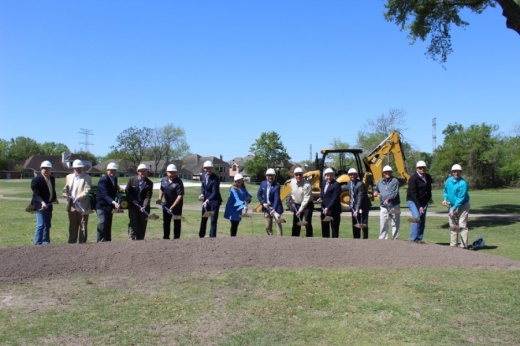The project entails building a 4-foot earthen barrier, or berm, around the Jersey Meadow Golf Course at a cost of $1.3 million. At the same time, a joint $5.7 million project will be underway to complete drainage improvements on some of the city's most flood-prone streets, including Wall, Crawford, Carlsbad and Tahoe streets as well as Capri Drive. The city was authorized by the Jersey Village City Council to approve both contracts at a Feb. 22 meeting.
"This isn’t something that is just a flash in the pan to make everyone feel good; this is something that will make a difference for many years to come," Jersey Village Mayor Andrew Mitcham said at an April 1 groundbreaking event. "When my daughters ... grow up and they are looking for a home, they are going to look in our city, and they are not going to be afraid to buy a home here because of flooding.”
The project was first conceptualized in a flood recovery study the city embarked on after the Tax Day flood, said former Mayor Justin Ray, who helped get the study rolling alongside former City Manager Mike Castro. Although the city is limited in what it can do to address flooding and largely relies on county and federal partnerships to pursue meaningful improvements, Ray said the devastation of the Tax Day event inspired him to see what could be done at the local level.
"When you have your home flooded, it is a traumatic experience," Ray said. "It is invasive. It comes into the sanctity of your home, and people are really, really hurt, and they are grieving. ... We assured [Jersey Village residents] that, as a community, as a citizenry, we were going to tackle this together.”
After the city adopted its flood plan in 2017, officials began to work on identifying ways to fund the projects. In an effort led by City Manager Austin Bleess, the city managed to secure roughly $6 million in grant funding, including $4 million from the Federal Emergency Management Agency.
As a result, Mitcham said the city's 180-day reserve fund was not affected by the project. Mitcham also worked with U.S. Rep. Lizzie Fletcher, D-Houston, to help speed up the process. Fletcher, who also spoke at the April 1 groundbreaking, helped the city cut down the length of the FEMA review, speeding the process up by an estimated four to six months.
Several residents who live on Wall Street also attended the groundbreaking. Carl Jacksits, a 15-year resident whose Wall Street home flooded during the Tax Day flood, said it meant a lot to him to know dirt was being turned.
"This project probably kept us from moving," he said.
The berm will travel around part of the perimeter of the golf course, roughly along the golf cart path with some deviations, officials said. Golf is expected to continue during construction with minimal interruptions and communication going out to residents on what to expect throughout the project.
Both contracts have a length of 300 days, but officials said they hope to see work largely completed by the end of the year.





